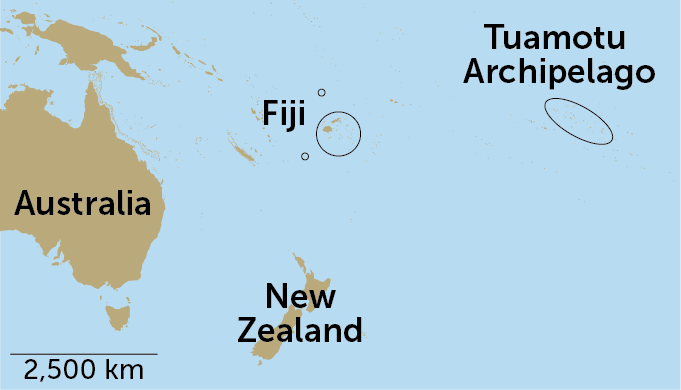This post was originally published on this site
In 1965, renowned bee biologist Charles Michener described a new species of masked bee from “an entirely unexpected region,” the Tuamotu Archipelago of French Polynesia. Michener named the bee Hylaeus tuamotuensis and noted that its nearest relatives live in New Zealand — some 3,000 miles away across the Pacific Ocean. How did a small bee make such a big journey?
It turns out that the answer was buzzing above scientists’ heads all along. By swinging insect nets high up in the trees, researchers discovered eight species of Hylaeus bees that had never been described before, including six that live in Fiji.
The island nation lies between French Polynesia and Australia, where Hylaeus diversity is highest, so the scientists suspect that the ancestors of H. tuamotuensis reached their remote home by island-hopping across the Pacific. As individual bees moved from island to island, they steadily evolved into separate species, researchers report February 26 in Frontiers in Ecology and Evolution.
Most bee species live in arid regions like the southwestern United States, says bee biologist Bryan Danforth of Cornell University, who was advised by the late Michener for his Ph.D. “We don’t think of bees as being terribly diverse in islands.”
Bee searchers usually snag their quarry by sweeping nets low to the ground. But during a trip to Fiji in 2019, evolutionary biologist James Dorey of Wollongong University in Australia took a different approach. He knew that some bees in Australia tend to fly in the canopy of eucalypt trees, or gum trees, and thought bees in Fiji might do the same. He equipped himself with a longer net and started swinging it skyward.
“As soon as I was able to sample a flowering tree, we were catching Hylaeus,” Dorey says. “It was clear that we had more than one [new] species from that one tree.”
Searching for bees in treetops is relatively rare. But “we’re starting to realize that, actually, there’s a lot of bee diversity up there,” Danforth says.

Dorey and his collaborators have a strong relationship with local Fijians, especially in Navai Village on the main island of Viti Levu, and with Fijian scientists like coauthor Marika Tuiwawa, a botanist at the University of the South Pacific. There is a lot of enthusiasm among Fijians for their native bees, Dorey says, and he hopes to train students there in bee collecting. Experts on Fiji’s bees, he says, should be Fijian.
While it’s clear that H. tuamotuensis is not alone in its remote island home, many mysteries remain: How did Hylaeus bees make it to the various islands and what path did they take?
It’s possible the bees were blown across the Pacific by storms, Danforth says, but he also thinks that their habit of nesting in wood may have something to do with the bees’ spread. “If you nest in wood and a piece of wood falls in the ocean, and that drifts thousands of kilometers and lands on a habitable spot, that’s a plausible way for these bees to disperse,” he says. “We know that other wood-nesting bees have done that.”

